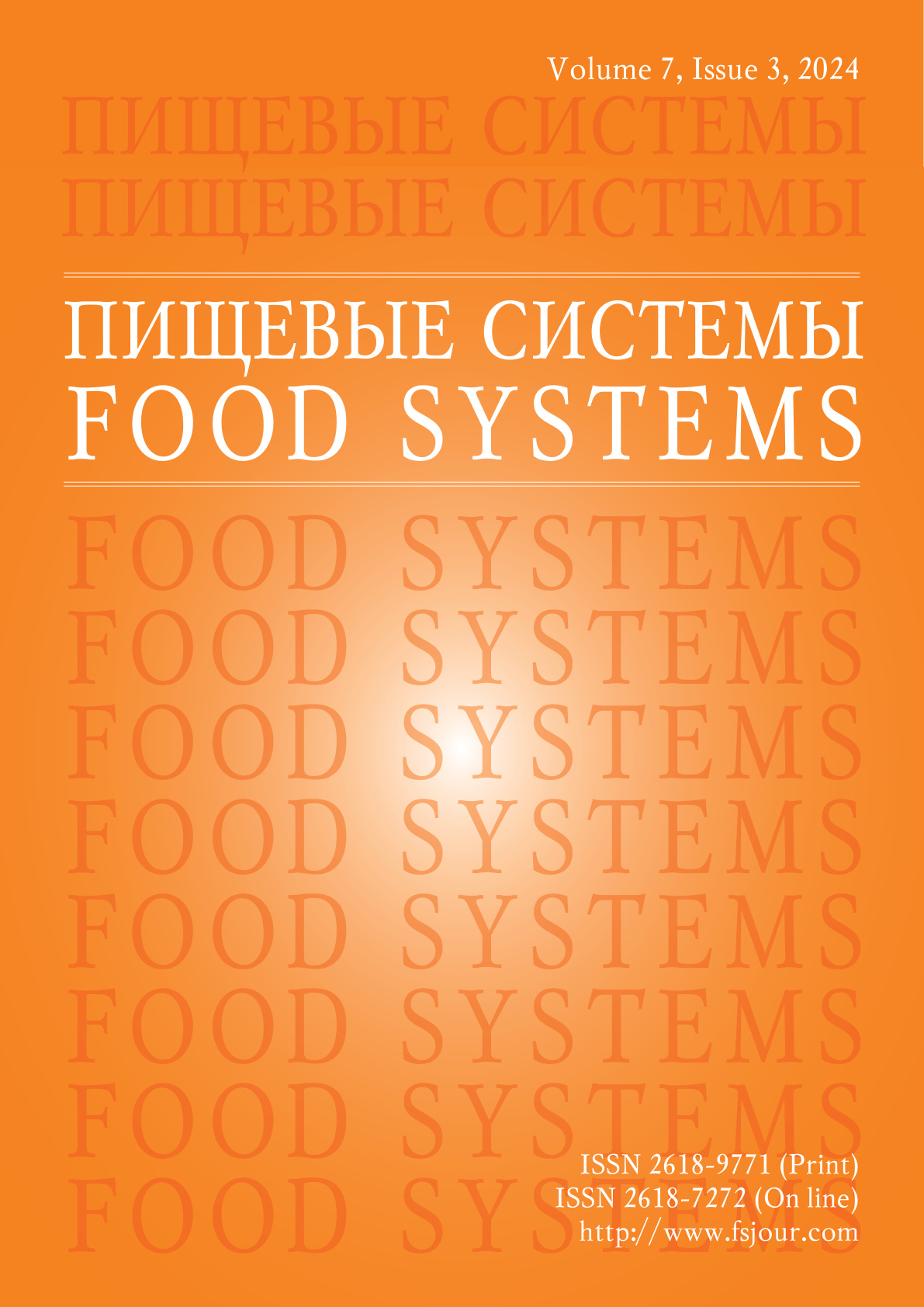Vol 7, No 3 (2024)
- Year: 2024
- Articles: 20
- URL: https://medbiosci.ru/2618-9771/issue/view/20785
- DOI: https://doi.org/10.21323/2618-9771-2024-7-3
Full Issue
Articles
Functional characteristics and molecular structural modification of plant proteins. Review
Abstract
 324-335
324-335


The use of alternative protein sources in quail diets: A review
Abstract
 336-344
336-344


Technological aspects of managing the structural and mechanical properties of wheat bread crumb
Abstract
 345-354
345-354


Current state and prospects of dihydroquercetin application in food industry
Abstract
 355-362
355-362


Development of gluten-free pasta with chickpeas as a wheat flour substitute and fortified with carob, beetroot, and spinach
Abstract
The study aimed to develop pasta dough using chickpeas as a substitute for wheat flour and fortified with carob, beetroot, and spinach. Three formulations of gluten-free pasta were prepared: F1 (chickpea flour 97% + carob powder 2% + CMC1%), F2 (chickpea flour 87% + carob powder 2% + beetroot powder 10% + CMC1%) and F3 (chickpea flour 87% + carob powder 2% + spinach powder 10% + CMC1%). Physical, chemical, rheological, and sensory characteristics of chickpea pasta were evaluated and compared to semolina flour (CS) as a control. In comparison with conventional wheat pasta, chickpea pasta has a higher content of protein, fiber, and polyphenolic compounds. The results indicated that the incorporation of chickpea as a main ingredient significantly increased the content of protein in the formulations of gluten-free pasta (17.50, 15.05 and 14.88% in F1, F3, and F2, respectively) compared to CS (12.10%). A similar trend was observed for the fiber content (0.45, 1.89, 2.16, and 2.29 in CS, F1, F2, and F3, respectively) and polyphenolic compounds (109.14, 112.14, 141.89, and 178.96 in CS, F1, F2, and F3, respectively). Chickpea pasta demonstrated strong acceptance across all sensory criteria, including texture, odor, shape, and taste. Therefore, this study suggests that chickpeas can serve as an effective substitute for wheat, thereby increasing the availability of healthy options for everyone, particularly for those with celiac disease, obesity, or diabetes.
 363-367
363-367


Sulfur dioxide in white sugar: Source of income, reference values
Abstract
 368-374
368-374


Application of whey protein microparticulates in the production of ice cream and other dairy products
Abstract
 375-383
375-383


Emerging pollutants: Risks in salmon fish migration. A review
Abstract
 384-393
384-393


Microplastics: Features of appearance, identification methods (subject review)
Abstract
 394-402
394-402


Allergy to aquatic biological resources as food
Abstract
 403-409
403-409


Lactobacilli as additional cultures in cheese making
Abstract
 410-419
410-419


World practice of wheat flour classification
Abstract
 420-426
420-426


The influence of storage conditions on the dynamics of physicochemical markers of champignon ( Agaricus bisporus ) quality
Abstract
 427-437
427-437


Utilization of artichoke ( Cynara scolymus L. ) by-products for enhancing nutritional value and phytochemical content of cookies
Abstract
This study was conducted to make functional cookies using powdered artichoke stems and bracts, which are rich in phytochemicals. The chemical composition and phytochemicals in wheat flour, artichoke bract powder, artichoke stem powder and the produced cookies were determined. Physical properties, color and sensory characteristics were determined in wheat flour cookies, artichoke bract powder cookies and artichoke stem powder cookies. The results showed that artichoke bract powder cookies (15%) contained the highest levels of ash and protein being 2.07% and 9.65%, respectively. The cookies with powdered artichoke stems (15%) had the greatest overall lipid content (14.65%). Furthermore, the highest total phenolic content, total flavonoid content, and antioxidant activity were found in artichoke by-products (stems and bracts). The panelists approved of up to 15% artichoke by-product powder added to wheat flour. It can be seen from the results that the artichoke by-products are a good source of phytochemicals, minerals, total protein and total lipids, which improves the quality of cookies. Therefore, it can be concluded that using artichoke by-products up to 15% enhanced the antioxidant properties and nutritional value of the baked cookies.
 438-443
438-443


Current developments in grain science. Review
Abstract
 444-453
444-453


Determination of optimal technological conditions for the manufacture of semi-finished products from gooseberry fruit
Abstract
 454-465
454-465


Hydrolysates of mare's milk proteins. Immunochemical and physico-chemical characteristics
Abstract
 466-472
466-472


The influence of the volume fraction of meat in dumplings on their cooking time
Abstract
 473-480
473-480


Colorimetric method for estimating the intensity of heat load during milk pasteurization
Abstract
 481-490
481-490


Sustainable agriculture development for food safety and nutrition
Abstract
Sustainable agriculture is a type of agriculture which, in addition to producing food and agricultural products, is also economically advantageous for farmers, socially correct, respectful of nature and the environment. Sustainable agriculture contributes to improving the quality of life of both farmers and society. Climate change, economic development and social equity influence the sustainable agriculture and require complex and shared solutions on a large scale. Sustainable agriculture includes different meanings, such as environmental, social and economic perspective. The environmental perspective is related to the development of virtuous processes that respect the planet's resources, the healthiness of the soil and water, guaranteeing the maintenance of biodiversity and avoiding the use of pesticides and chemical agents. The social and economic perspective is the ability to meet the global demand of both industrialized and developing countries by ensuring the improvement of the protection of human rights and solidarity-based economic development, the quality of life of farmers, the ethical treatment of animals. The aim of this work is to discuss the implications and perspectives of sustainable agriculture in relation to food production.
 491-504
491-504










